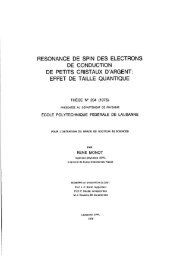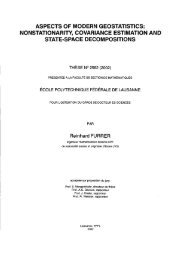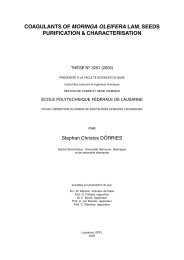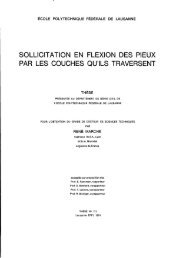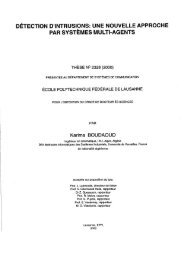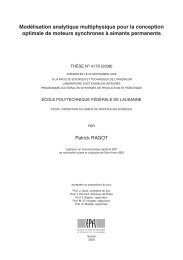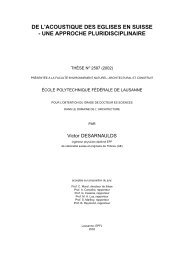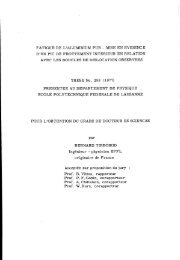COMPILING SCALA FOR THE JAVA VIRTUAL MACHINE - EPFL
COMPILING SCALA FOR THE JAVA VIRTUAL MACHINE - EPFL
COMPILING SCALA FOR THE JAVA VIRTUAL MACHINE - EPFL
You also want an ePaper? Increase the reach of your titles
YUMPU automatically turns print PDFs into web optimized ePapers that Google loves.
<strong>COMPILING</strong> <strong>SCALA</strong> <strong>FOR</strong> <strong>THE</strong> <strong>JAVA</strong> <strong>VIRTUAL</strong> <strong>MACHINE</strong><br />
THÈSE N O 3302 (2005)<br />
PRÉSENTÉE À LA FACULTÉ IN<strong>FOR</strong>MATIQUE ET COMMUNICATIONS<br />
Institut d'informatique fondamentale<br />
SECTION D'IN<strong>FOR</strong>MATIQUE<br />
ÉCOLE POLYTECHNIQUE FÉDÉRALE DE LAUSANNE<br />
POUR L'OBTENTION DU GRADE DE DOCTEUR ÈS SCIENCES<br />
PAR<br />
Michel SCHINZ<br />
ingénieur informaticien diplômé EPF<br />
de nationalité suisse et originaire de Neuchâtel (NE)<br />
acceptée sur proposition du jury:<br />
Prof. M. Odersky, directeur de thèse<br />
Prof. P. Ienne, rapporteur<br />
Prof. S. Krishnamurthi, rapporteur<br />
Prof. M. Viroli, rapporteur<br />
Lausanne, <strong>EPFL</strong><br />
2005
Contents<br />
1 Introduction 7<br />
1.1 Scope ................................ 7<br />
1.2 Background ............................ 8<br />
1.2.1 The Scala programming language ........... 8<br />
1.2.2 The Java virtual machine ................ 9<br />
1.2.3 The Scala compiler .................... 10<br />
1.3 Inheritance graph notation .................... 13<br />
2 Mixins 15<br />
2.1 Introduction ............................ 15<br />
2.1.1 Single inheritance ..................... 15<br />
2.1.2 Multiple inheritance ................... 15<br />
2.1.3 Mixin inheritance ..................... 16<br />
2.1.4 Trait inheritance ...................... 16<br />
2.2 Mixin inheritance in Scala .................... 17<br />
2.2.1 Mixin example ...................... 18<br />
2.3 Encoding mixins on the JVM .................. 19<br />
2.3.1 Typing aspect ....................... 20<br />
2.3.2 Code sharing aspect ................... 20<br />
2.3.3 Encoding used by scalac ................ 22<br />
2.4 Interfaces for types ........................ 25<br />
2.4.1 The AddInterfaces phase ................ 25<br />
2.4.2 Unmixable classes .................... 26<br />
2.4.3 Subclasses of Java classes ................ 27<br />
2.4.4 Private members ..................... 28<br />
2.5 Inlining mixin code ........................ 29<br />
2.5.1 The ExpandMixins phase ................ 29<br />
2.5.2 Mixin type parameters .................. 30<br />
2.5.3 Mixin constructors .................... 30<br />
2.5.4 Private members ..................... 31<br />
2.5.5 Overridden members .................. 31
II CONTENTS<br />
2.5.6 Nested classes ....................... 31<br />
2.6 Example translation ........................ 32<br />
2.7 Cost of code copying ....................... 32<br />
3 Run Time Types 35<br />
3.1 Introduction ............................ 35<br />
3.1.1 Pattern matching ..................... 35<br />
3.1.2 Reflection ......................... 36<br />
3.1.3 Type-safe serialisation .................. 36<br />
3.2 Run time types in Scala ...................... 37<br />
3.2.1 The language of types .................. 37<br />
3.2.2 Run time types of values ................. 37<br />
3.2.3 Operations on run time types .............. 38<br />
3.2.4 Pattern matching ..................... 38<br />
3.2.5 Implementation restrictions ............... 40<br />
4 Representing Run Time Types 43<br />
4.1 Introduction ............................ 43<br />
4.2 Mapping source types to JVM types .............. 43<br />
4.2.1 Full erasure ........................ 44<br />
4.2.2 Isomorphic mapping ................... 44<br />
4.2.3 Partial erasure ....................... 44<br />
4.2.4 Erasure of terms ..................... 45<br />
4.2.5 Mapping examples .................... 45<br />
4.2.6 The Scala mapping .................... 46<br />
4.3 Type representations ....................... 51<br />
4.3.1 A note about concurrency ................ 53<br />
4.3.2 Class types ......................... 54<br />
4.3.3 Java class types ...................... 56<br />
4.3.4 Scala class types ...................... 56<br />
4.3.5 Array types ........................ 59<br />
4.3.6 Singleton types ...................... 62<br />
4.3.7 Compound types ..................... 62<br />
4.3.8 Value types ........................ 64<br />
4.3.9 Special types ....................... 65<br />
5 Compiling Run Time Types 67<br />
5.1 Introduction ............................ 67<br />
5.2 Compiling type expressions ................... 67<br />
5.3 Polymorphic methods and classes ............... 68<br />
5.4 Instantiation methods and type constructors ......... 68
CONTENTS III<br />
5.5 Type accessor methods ...................... 73<br />
5.6 Type reflection method ...................... 74<br />
5.7 Membership tests ......................... 75<br />
5.8 Type casts ............................. 77<br />
5.9 Default values ........................... 78<br />
5.10 Array creation ........................... 78<br />
5.11 Possible improvements ...................... 79<br />
6 Performance impact of run time types 81<br />
6.1 Micro benchmark ......................... 81<br />
6.2 Large benchmarks ......................... 84<br />
6.2.1 Benchmark programs .................. 84<br />
6.2.2 Execution statistics .................... 86<br />
6.2.3 Execution time ...................... 88<br />
6.2.4 Code size ......................... 89<br />
6.2.5 Memory consumption .................. 89<br />
7 Related Work 91<br />
7.1 Mixins ............................... 91<br />
7.1.1 Jam ............................. 91<br />
7.1.2 MIXED<strong>JAVA</strong> ........................ 92<br />
7.1.3 MIXGEN .......................... 93<br />
7.1.4 Animorphic Smalltalk .................. 93<br />
7.2 Run time types .......................... 94<br />
7.2.1 Heterogeneous translations ............... 94<br />
7.2.2 Homogeneous translations ............... 96<br />
8 Conclusion and Future Work 101<br />
A Scala’s type language 103<br />
A.1 Singleton types ..........................103<br />
A.2 Class types .............................104<br />
A.3 Compound types .........................105
Version abrégée<br />
Scala est un nouveau langage de programmation, développé à l’<strong>EPFL</strong>,<br />
combinant les principales caractéristiques des langages orientés-objets et<br />
fonctionnels. Scala a été conçu pour interagir aisément aussi bien avec<br />
Java qu’avec .NET. Pour ce faire, son compilateur peut produire des programmes<br />
s’exécutant sur la machine virtuelle de chacune de ces deux plateformes.<br />
Cette thèse se focalise sur la compilation de deux concepts importants<br />
de Scala : l’héritage par mixins et les types à l’exécution. Les techniques<br />
de compilation sont présentées dans le cadre de la machine virtuelle Java,<br />
mais pourraient être adaptées sans difficulté à d’autres environnements<br />
similaires.<br />
L’héritage par mixins est une forme d’héritage relativement récente,<br />
plus puissante que l’héritage simple, mais évitant la complexité de l’héritage<br />
multiple. Nous proposons deux techniques de compilation de cet<br />
héritage : par copie de code, et par délégation. La mise en œuvre actuelle,<br />
basée sur la copie de code, est ensuite présentée puis justifiée.<br />
Par types à l’exécution on entend la possibilité qu’a un programme<br />
d’examiner, lors de son exécution, le type de ses valeurs. Cette possibilité<br />
est d’une part intéressante en soit, puisqu’elle offre de nouveaux moyens<br />
au programmeur. D’autre part, elle est requise pour la mise en œuvre<br />
d’autres concepts de haut niveau, comme le filtrage de motifs, la sérialisation<br />
sûre, ou la réflection. Nous proposons une technique de compilation<br />
basée sur la représentation des types sous forme de valeurs, et montrons<br />
comment il est possible d’utiliser les types à l’exécution de la machine virtuelle<br />
sous-jacente comme base pour les types à l’exécution de Scala.<br />
Les techniques présentées dans cette thèse ont été mises en œuvre dans<br />
le cadre de notre compilateur Scala, nommé scalac. Cela nous a permis<br />
d’évaluer la qualité des techniques proposées, en particulier leur impact<br />
sur les performances des programmes. Cette évaluation s’est faite sur des<br />
programmes réels, de taille importante.
Abstract<br />
Scala is a new programming language developed at <strong>EPFL</strong> and incorporating<br />
the most important concepts of object-oriented and functional languages.<br />
It aims at integrating well with the Java and .NET platforms: their<br />
respective libraries are accessible without glue code, and the compiler can<br />
produce programs for both virtual machines.<br />
This thesis focuses on the compilation of two important concepts of<br />
Scala : mixin inheritance and run time types. The compilation techniques are<br />
presented in the context of the Java virtual machine, but could be adapted<br />
easily to other similar environments.<br />
Mixin inheritance is a relatively recent form of inheritance, offering<br />
new capabilities compared to single inheritance, without the complexity<br />
of multiple inheritance. We propose two implementation techniques<br />
for mixin inheritance: code copying and delegation. The implementation<br />
used in the Scala compiler is then presented and justified.<br />
Run time types make it possible for a program to examine the type of<br />
its values during execution. This possibility is interesting in itself, offering<br />
new capabilities to the programmer. Furthermore, run time types are<br />
also required to implement other high level concepts, like pattern matching,<br />
type-safe serialisation and reflection. We propose an implementation<br />
technique based on the representation of types as values, and show how<br />
to use the run time types of the underlying virtual machine to implement<br />
those of Scala.<br />
The techniques presented in this thesis have been implemented in our<br />
Scala compiler, scalac. This enabled us to evaluate these techniques, in<br />
particular their impact on the performances of programs. This evaluation<br />
was performed on several real, non-trivial programs.



